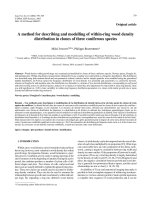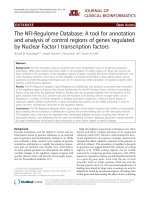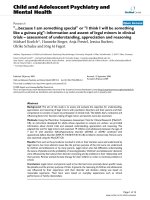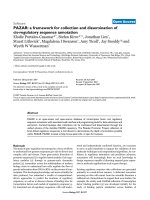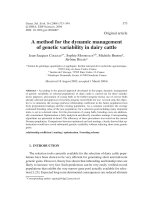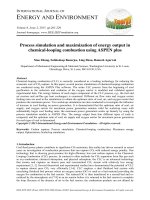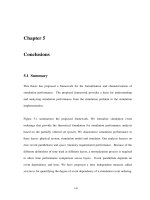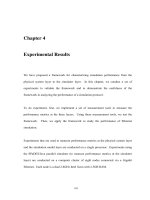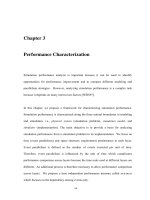A model for simulation and generation of surrounding vehicles in sriving simulators
Bạn đang xem bản rút gọn của tài liệu. Xem và tải ngay bản đầy đủ của tài liệu tại đây (728.93 KB, 118 trang )
Linköping Studies in Science and Technology
Licentiate Thesis No. 1203
A model for simulation and generation of
surrounding vehicles in driving simulators
Johan Janson Olstam
LiU-TEK-LIC- 2005:58
Dept. of Science and Technology
Linköpings Universitet, SE-601 74 Norrköping, Sweden
Norrköping 2005
Tai ngay!!! Ban co the xoa dong chu nay!!!
A model for simulation and generation of surrounding vehicles in driving
simulators
© 2005 Johan Janson Olstam
Department of Science and Technology
Linkưpings universitet,
SE-601 74 Norrköping,
Sweden.
ISBN 91-85457-51-5
ISSN 0280-7971
LiU-TEK-LIC 2005:58
Printed by UniTryck, Linköping, Sweden 2005
Acknowledgements
First of all I would like to thank my supervisors Jan Lundgren, Linköping
University (LiU), Department of Science and Technology (ITN), and Pontus
Matstoms, VTI, for their invaluable support and advices. Many thanks also to
Mikael Adlers, VTI, who I have been working with during the integration and
testing within the VTI Driving simulator III. He has a great part in that integration
went successfully. Thanks also to the Swedish Road Administration (SRA),
Ruggero Ceci, for funding this work.
I would also like to show appreciation to my other colleagues at ITN/LiU and
VTI, whom make ITN/LiU and VTI stimulating places to work at. Special thanks
to my roommate and PhD student colleague Andreas Tapani and to my other PhD
student colleagues for very interesting and useful discussions, to Arne Carlsson,
VTI, for sharing his knowledge within the traffic theory and simulation area, to
Anne Bolling and Selina Mård Berggren, VTI, for their help during the design and
the realization of the conducted driving simulator experiment, to Lena Nilsson and
Jerker Sundström, VTI, for invaluable comments, and to the members of the VTI
driving simulator group, Staffan, Mikael, Mats, Håkan, Håkan, and Göran, for
sharing their massive experience within the driving simulator area.
I would also like to express my gratitude to my family and friends for their
encouragement and support. Last but not least, I would like to give all my love to
Lin and to my two cuddly cats Marion and Morriz.
i
ii
Abstract
Driving simulators are used to conduct experiments on for example driver
behavior, road design, and vehicle characteristics. The results of the experiments
often depend on the traffic conditions. One example is the evaluation of cellular
phones and how they affect driving behavior. It is clear that the ability to use
phones when driving depends on traffic intensity and composition, and that
realistic experiments in driving simulators therefore has to include surrounding
traffic.
This thesis describes a model that generates and simulates surrounding vehicles
for a driving simulator. The proposed model generates a traffic stream,
corresponding to a given target flow and simulates realistic interactions between
vehicles. The model is built on established techniques for time-driven microscopic
simulation of traffic and uses an approach of only simulating the closest
neighborhood of the driving simulator vehicle. In our model this closest
neighborhood is divided into one inner region and two outer regions. Vehicles in
the inner region are simulated according to advanced behavioral models while
vehicles in the outer regions are updated according to a less time-consuming
model. The presented work includes a new framework for generating and
simulating vehicles within a moving area. It also includes the development of
enhanced models for car-following and overtaking and a simple mesoscopic
traffic model.
The developed model has been integrated and tested within the VTI Driving
simulator III. A driving simulator experiment has been performed in order to
check if the participants observe the behavior of the simulated vehicles as realistic
or not. The results were promising but they also indicated that enhancements
could be made. The model has also been validated on the number of vehicles that
catches up with the driving simulator vehicle and vice versa. The agreement is
good for active and passive catch-ups on rural roads and for passive catch-ups on
freeways, but less good for active catch-ups on freeways.
iii
iv
Contents
1
INTRODUCTION .........................................................................................1
1.1
1.2
1.3
1.4
1.5
1.6
2
BACKGROUND...........................................................................................1
AIM ...........................................................................................................3
DELIMITATIONS ........................................................................................3
THESIS OUTLINE ........................................................................................3
CONTRIBUTIONS .......................................................................................4
PUBLICATIONS ..........................................................................................5
TRAFFIC SIMULATION ............................................................................7
2.1
CLASSIFICATION OF TRAFFIC SIMULATION MODELS ..................................7
2.2
MICROSCOPIC TRAFFIC SIMULATION .........................................................8
2.3
BEHAVIORAL MODEL SURVEY ...................................................................9
2.3.1
Car-following models ....................................................................10
2.3.2
Lane-changing models...................................................................16
2.3.3
Overtaking models .........................................................................22
2.3.4
Speed adaptation models ...............................................................25
3
SURROUNDING TRAFFIC IN DRIVING SIMULATORS ..................27
3.1
DRIVING SIMULATOR EXPERIMENTS........................................................27
3.1.1
Experiments, scenarios, and scenes...............................................27
3.1.2
Design issues..................................................................................28
3.2
USING STOCHASTIC TRAFFIC IN DRIVING SIMULATOR SCENARIOS ...........29
3.2.1
The stochastic traffic – Driving simulator dilemma ......................29
3.2.2
Stochastic traffic simulation and critical events............................30
3.3
DEMANDS ON TRAFFIC SIMULATION WHEN USED IN DRIVING
SIMULATORS ...........................................................................................31
3.4
RELATED RESEARCH ...............................................................................32
3.4.1
Rule-based models .........................................................................34
3.4.2
State machines ...............................................................................35
3.4.3
The eco-resolution principle..........................................................36
4
THE SIMULATION MODEL....................................................................39
4.1
THE SIMULATION FRAMEWORK ...............................................................39
4.1.1
Representation of vehicles and drivers..........................................39
4.1.2
The moving window .......................................................................40
4.1.3
The simulated area.........................................................................42
4.1.4
The candidate areas.......................................................................42
4.1.5
Vehicle update technique ...............................................................45
4.2
VEHICLE GENERATION ............................................................................48
4.2.1
Generation algorithm ....................................................................48
4.2.2
Generation of new vehicles on freeways........................................50
4.2.3
Generation of new vehicle and vehicle platoons on rural roads...53
4.2.4
Initialization of the simulation.......................................................54
4.3
BEHAVIORAL MODELS ............................................................................55
4.3.1
Speed adaptation............................................................................55
4.3.2
Car-following.................................................................................57
4.3.3
Lane-changing ...............................................................................60
4.3.4
Overtaking .....................................................................................61
v
4.3.5
4.3.6
5
INTEGRATION WITH THE VTI DRIVING SIMULATOR III...........67
5.1
5.2
5.3
6
Passing...........................................................................................64
Oncoming avoidance .....................................................................64
THE VTI DRIVING SIMULATOR III ..........................................................67
THE INTEGRATED SYSTEM.......................................................................67
COMMUNICATION WITH THE SCENARIO MODULE ....................................68
VALIDATION .............................................................................................71
6.1
HOW SHOULD THE MODEL BE VALIDATED? .............................................71
6.2
NUMBERS OF ACTIVE AND PASSIVE OVERTAKINGS ..................................72
6.2.1
Simulation design...........................................................................73
6.2.2
Results............................................................................................74
6.3
USER EVALUATION .................................................................................79
6.3.1
Experimental design ......................................................................79
6.3.2
Scenario design..............................................................................80
6.3.3
Evaluation design ..........................................................................81
6.3.4
Results and analyses of the questionnaire .....................................82
6.3.5
Results and analyses of the interview questions ............................83
6.4
DISCUSSION ............................................................................................86
6.4.1
Some additional observations........................................................87
7
CONCLUSIONS AND FUTURE RESEARCH........................................89
8
REFERENCES.............................................................................................91
Appendices
APPENDIX A – DRIVER/VEHICLE PARAMETER VALUES
APPENDIX B – OVERTAKING PARAMETERS
APPENDIX C – QUESTIONNAIRE
APPENDIX D – INTERVIEW QUESTIONS
APPENDIX E – ANSWERS FROM THE INTERVIEW QUESTIONS
vi
1 Introduction
1.1 Background
Traffic safety is a severe and important problem. Many accidents are caused by
failures in the interaction between the driver, the vehicle, and the traffic system.
The number of driving related interactions is increasing. Drivers nowadays also
interact with different intelligent transportation systems (ITS), advanced driver
assistance systems (ADAS), in-vehicle information systems (IVIS), and NOMAD
devices, such as mobile phones, personal digital assistants, and portable
computers. These technical systems influence drivers’ behavior and their ability to
drive a vehicle. To be able to evaluate how different ITS, ADAS, IVIS, NOMADsystems, or road and signal control designs etc influence drivers, knowledge about
the interactions between drivers, vehicles and environment are essential.
To get this knowledge researchers conduct behavioral studies and experiments,
which either can be conducted in the real traffic system, on a test track, or in a
driving simulator. The real world is of course the most realistic environment, but
it can be unpredictable regarding for instance weather-, road- and traffic
conditions. It is therefore often hard to design real world experiments from which
it is possible to draw statistically significant conclusions. Some experiments are
also too dangerous or expensive to conduct in the real world and other are
impossible due to laws or ethical reasons. Test tracks offer a safer environment
and the possibility of giving test drivers more equal conditions and thereby
decreasing the statically uncertainty. However, test tracks lack a lot in realism and
it can be hard to evaluate how valid results from a test track study are for driving
on a real road. Driving simulators on the other hand offer a realistic environment
in which test conditions can be controlled and varied in a safe way.
A driving simulator is designed to imitate driving a real vehicle, see Figure 1.1
for an illustration. The driver place can be realized with a real vehicle cabin or
only a seat with a steering wheel and pedals, and anything in between. The
surroundings are presented for the driver on a screen. A vehicle model is used to
calculate the simulator vehicle’s movements according to the driver’s use of the
steering wheel and the pedals. Some driving simulators use a motion system in
order to support the driver’s visual impression of the simulator vehicle’s
movements. Last but not least a driving simulator include a scenario module that
includes the specification of the road, the environment, and all other actors and
events.
1
Figure 1.1 The VTI Driving Simulator III (Source: Swedish National Road and
Transport Research Institute (VTI) (2004))
Driving simulators are used to conduct experiments in many different areas
such as:
•
•
•
•
•
•
Alcohol, medicines and drugs.
Driving with disabilities.
Technical systems, such as ITS, ADAS, IVIS, and NOMAD systems.
Fatigue
Road design
Vehicle design
Driving simulators can also be used for training purposes. One example is the
TRAINER simulator that was developed to work as a complimentary vehicle in
driving license schools, (Gregersen et al., 2001). The TRAINER simulator offers
great possibilities to train actions that are unsafe, difficult or impossible to train in
the real road network. This could be anything between basic maneuvering to
emergency situations.
It is important that the performance of the simulator vehicle, the visual
representation, and the behavior of surrounding objects are realistic in order for
the driving simulator to be a valid representation of real driving. It is for instance
clear that the ambient vehicles must behave in a realistic and trustworthy way.
Ambient vehicles influence the driver’s mental load and thereby his or her ability
to drive the vehicle. A good representation of the ambient vehicles is especially
important in simulator studies where the traffic intensity and composition has a
large impact on the driver’s ability to drive the vehicle. This can for instance be in
experiments concerning road design, the use of new technical equipment, or
fatigue. It is not only important that the behavior of a single driver is realistic, but
2
also that the behavior of the whole traffic stream is realistic. For instance, drivers
who drive fast expect to catch up with more vehicles than catches up with them
and vice versa.
A realistic simulation of surrounding vehicles, and thereby traffic, can be
achieved by combining a driving simulator with a model for microscopic
simulation of traffic. Micro-simulation has become a very popular and useful tool
in studies of traffic systems. Micro models use different sub-models for carfollowing, lane-changing, speed adaptation, etc. to simulate driver behavior at a
microscopic level. The sub-models, hereby called behavioral models, use the
current road and traffic situation as inputs and generates individual driver’s
decisions regarding for example which acceleration to apply and which lane to
travel in as outputs. Stochastic functions are often used to model variation in
driver behavior, both among drivers and over time for a specific driver. However,
stochastic traffic simulation models have traditionally not been used to simulate
ambient vehicles in driving simulators. The usual approach has instead been to
simulate the ambient vehicles according to deterministic models. There are for
several reasons desirable to keep the variation in test conditions between different
drivers as low as possible. By using stochastic simulation of ambient traffic,
drivers will experience different situations at the micro level depending on how
they drive. The simulator driver’s conditions will still be comparable at a higher,
more aggregated, level, if this is sufficient or not varies depending on the type of
experiment. For some experiments, equal conditions at the micro level are
essential and stochastic simulation may not be suitable to use. In other
experiments, comparable conditions at a higher level are sufficient.
1.2 Aim
The aim of this thesis is to develop, implement, and validate a real-time running
traffic simulation model that is able to generate and simulate surrounding vehicles
in a driving simulator. This includes integration of the developed model and a
driving simulator. The model should both simulate individual vehicle-driver units
and the traffic stream that they are a part of, in a realistic way. The simulated
vehicle-driver units should behave realistically concerning acceleration, lanechanging, and overtaking behavior, as well as concerning speed choices. The
vehicles should also appear in the traffic stream in such a way that headways,
vehicle types, speed distributions, etc. correspond to real data.
1.3 Delimitations
The simulation model has been delimited to only deal with freeways with two
lanes in each direction and to rural roads with oncoming traffic. The model does
not deal with ramps on freeways or intersections on rural roads. Consequently, the
thesis does not deal with simulation of urban traffic situations.
Some driving simulator experiments include critical situations or events. To
create such situations autonomous vehicles has to be combined with vehicles with
predetermined behavior. The thesis only discusses this topic to a limited extent.
1.4 Thesis outline
Chapter 2 gives an introduction to the field of microscopic simulation of traffic.
The chapter includes a survey of common car-following, lane-changing,
overtaking, and speed adaptation models.
3
Chapter 3 includes an introduction to driving simulator experiments and to the
field of simulation of surrounding vehicles in driving simulators. It also include a
discussion on the advantages, disadvantages, and difficulties of using stochastic
traffic simulation for simulating surrounding vehicles in driving simulators. The
chapter ends with a description of related research.
In Chapter 4 the proposed model is presented. First, the simulation framework
is presented. Then follows the presentation of the technique used to generate new
vehicles. The chapter ends with a description of the utilized behavioral models
and calibration of the involved parameters.
Chapter 5 describes the integration of the proposed simulation model and the
VTI driving simulator III. The chapter starts with a short description of the driving
simulator and then follows the description of the integrated system.
The performed validation of the model is presented in Chapter 6. The chapter
starts with a discussion on how to validate this kind of models. Then follows a
description and results from a validation of the number of vehicles that catches up
with the driving simulator vehicle and vice versa. The third section describes a
driving simulator experiment that was conducted in order to validate the simulated
vehicles’ behavior. The chapter ends with a discussion and some additional
observations made during tests in the driving simulator.
Chapter 7 ends the thesis with a summary and a discussion on future research
needs and possibilities.
1.5 Contributions
The main contribution of this thesis is the developed traffic simulation model,
which is able to simulate ambient vehicles in a driving simulator on freeways and
on rural roads with oncoming traffic. The contributions also include:
•
•
•
•
•
•
•
•
4
A summary over commonly used behavioral models for car-following,
lane-changing, overtaking, and speed adaptation.
An investigation of difficulties, benefits, advantages and disadvantages
with using stochastic micro simulation of traffic for simulation of ambient
traffic in a driving simulator.
Improvements of a technique for generating freeway traffic on a moving
area around a driving simulator and a further development of this
technique to also fit generation of vehicles on rural roads without a barrier
between oncoming traffic.
A new simple mesoscopic traffic simulation model that simulates
individual vehicles using speed-flow diagrams. The model is used to
simulate vehicles far away from the simulator vehicle.
A new version of the TPMA (Davidsson et al., 2002) car-following model,
including a new deceleration model.
An enhanced version of the VTISim (Brodin et al., 1986) overtaking
model, which includes new models for the behavior during the overtaking
and at abortion of overtakings.
Integration of the simulation model and the VTI Driving simulator III
Presentation of different approaches that can be used to validate models
for simulating surrounding vehicles in driving simulators.
1.6 Publications
Some parts of this thesis have been published in other publications. The first
version of the framework for generation and simulation of vehicles on freeways
was originally presented in
Janson Olstam, J. and J. Simonsson (2003), Simulerad trafik till VTI:s
körsimulator - en förstudie (Simulated traffic for the VTI driving simulator - a
feasibility study, In Swedish). VTI Notat 32-2003. Swedish National Road and
Transport Research Institute (VTI), Linköping, Sweden.
A partly enhanced version of this framework was later presented in
Janson Olstam, J. (2003). “Traffic Generation for the VTI Driving
Simulator”. In Proceedings of: Driving Simulator Conference - North
America, DSC-NA 2003, Dearborn, Michigan, USA.
The generation and simulation framework for simulation of rural road traffic
for driving simulators was first presented in:
Janson Olstam, J. (2005). “Simulation of rural road traffic for driving
simulators”. In Proceedings of: 84th Annual meeting of the Transportation
Research Board, Washington D.C., USA.
Section 2.3.1 in the thesis includes a survey over car-following models. The
main part of this survey has been presented in:
Janson Olstam, J. and A. Tapani (2004), Comparison of Car-following
models. VTI meddelande 960A and LiTH-ITN-R-2004-5. Swedish National
Road and Transport Research Institute (VTI) and Linköping University,
Department of Science and Technology, Linköping, Sweden.
5
2 Traffic simulation
The societies of today need well working traffic and transportation systems.
Congestion and traffic jams have become recurrent problems in most of the larger
cities and also more common in smaller cities. In order to avoid congestion and to
optimize the traffic systems with respect to capacity, accessibility and safety,
traffic planners need tools that can predict the effects of different road designs,
management strategies, and increased travel demands. Researchers and developers
have therefore during the last decades developed many different types of models
and tools that deal with these kinds of issues. The rapid development in the
personal computer area has created new possibilities to develop enhanced traffic
modeling tools. Traffic models are mainly based on analytical or simulation
approaches. The analytical models often use queue theory, optimization theory or
differential equations that can be solved analytical to model road traffic. These
kinds of models are very useful, but often lack the possibility of studying how the
dynamics of a traffic system varies over time. Simulation models on the other
hand offer this possibility. They model how the traffic changes over time and use
stochastic functions in order to reproduce the dynamics of a traffic system.
Traffic simulation has become a powerful and cost-efficient tool for
investigating traffic systems. It can for instance be used for evaluation of different
road and regulation designs, ITS-applications or traffic management strategies.
Traffic simulation models offer the possibility to experiment in a safe and nondisturbing way with an existing or non-existing traffic system. As all models,
traffic simulation models must be calibrated and validated in order to generate
trustworthy results. This is often a very time-consuming task and sometimes limits
the models cost-efficiency.
2.1 Classification of traffic simulation models
There are many different kinds of traffic models and there are also a couple of
different ways to classify traffic models. Traffic simulation models are typical
classified according to the level of detail at which they represent the traffic
stream. Three categories are generally used, namely: Microscopic, Mesoscopic
and Macroscopic.
Microscopic models represent the traffic stream at a very high level of detail.
They model individual vehicles and the interaction between them. Microscopic
models incorporate sub-models for acceleration, speed adaptation, lane-changing,
gap acceptance etc., to describe how vehicles move and interact with each other
and with the infrastructure. Several models have been developed and the most
well-known are probably AIMSUN (Barceló et al., 2002), VISSIM (PTV, 2003),
Paramics (Quadstone, 2004a, Quadstone, 2004b), MITSIMLab (Toledo et al.,
2003), and CORSIM (FHWA, 1996).
Mesoscopic models often represent the traffic stream at a rather high level of
detail, either by individual vehicles or packets of vehicles. The difference
compared to micro models is that interactions are modeled with lower detail. The
interactions between vehicles and the infrastructure are typically based on
macroscopic relationships between, for example, flow, speed and density.
Examples of mesoscopic simulation models are DYNASMART (Jayakrishnan et
al., 1994) and CONTRAM (Taylor, 2003).
Macroscopic models use a low level of detail, both regarding the representation
of the traffic stream and interactions. Instead of modeling individual vehicles, the
7
macro models use aggregated variables as flow, speed and density to characterize
the traffic stream. Macro models commonly use speed-flow relationships and
conservation equations to model how traffic propagate thru the modeled network.
Examples of macroscopic simulation models are METANET/METACOR
(Papageorgiou et al., 1989, Salem et al., 1994) and the Cell Transmission model
(Daganzo, 1994, Daganzo, 1995).
2.2 Microscopic traffic simulation
Microscopic traffic simulation models, hereby called micro or traffic simulation
models, simulate individual vehicles. The general approach is to treat a driver and
a vehicle as one unit. As in reality, these vehicle-driver units interact with each
other and with the surrounding infrastructure. Micro models consist of several
sub-models, hereby called behavioral models, that each handles specific
interactions. The most essential behavioral model is the car-following model,
which handles the longitudinal interaction between two preceding vehicles. Other
important behavioral models include models for lane-changing, gap-acceptance,
overtaking, ramp merging, and speed adaptation. The sub-models needed depend
on which type of road that the model should be able to simulate. Lane-changing
models are for instance only necessary when simulating urban or freeway
environments and are not needed in models for two lane highways without a
barrier between oncoming lanes. The most common behavioral models will be
presented in more detail in Section 2.3.
Most micro models are able to simulate urban or freeway networks. The most
well known models for these environments are also the ones presented in Section
2.1 (AIMSUN, VISSIM, Paramics, MITSIMLab, and CORSIM). Only a couple of
models for two-lane highways with oncoming traffic have been developed. The
state-of-the-art in rural road models includes the Two-Lane Passing (TWOPAS)
model (Leiman et al., 1998), the Traffic on Rural Roads (TRARR) model (Hoban
et al., 1991), and the VTISim model (Brodin et al., 1986). The VTISim model is
currently being further developed in the Rural Road Traffic Simulator (RuTSim)
model (Tapani, 2005).
In order to model that behavior and preferences varies among drivers, each
vehicle driver unit is assigned different driver characteristics parameters. These
parameters commonly include vehicle length, desired speed, desired following
distance, possible or desired acceleration and deceleration rates, etc. The variation
among the population is generally described by a distribution function and
individual parameter values are drawn from the specified distribution. We can for
example assume that desired speeds on freeways follows a normal distribution
with mean 111 km/h and a standard deviation of 11 km/h.
Micro models are generally time-discrete, but some event based models has
also been developed, see for instance Brodin and Carlsson (1986). The basic
principle of a time discrete model is that time is divided into small time steps,
commonly between 0.1 and 1 second. At each time step the model updates every
vehicle according to the set of behavioral models. At the end of the time step the
simulation clock is increased and the simulation enters the next time step.
Microscopic simulation models have traditionally been used to perform
capacity and level-of-service evaluations of different road designs and
management strategies. During the last decade, micro models have also in greater
extent been used to evaluate different ITS-applications for example Intelligent
8
Speed Adaptation (Liu et al., 2000) or Adaptive Cruise Control systems
(Champion et al., 2001). Research has also been made within in the area of
combining micro simulation and different safety indicators to perform safety
analysis of different road and intersection designs, see for example Archer (2005)
and Gettman et al. (2003).
Even though micro models work on a micro level and simulate individual
vehicles, they have mainly been used to generate macroscopic outputs such as
average speeds, flows, and travel times. A large part of the calibration and
validation of micro models are therefore generally performed at a macroscopic
level. The different behavioral model has to various extents been calibrated and
validated at a micro level. However, very little effort has been put into calibrating
and validating combinations of behavioral models at a micro level, for example if
a car-following model in combination with a lane-changing model generates valid
results at a micro level.
2.3 Behavioral model survey
In order to be usable and well performing, traffic simulation models must be
based on high-quality behavioral models. To generate realistic behavior is of
course the most important property of a good behavioral model, but not the only
desirable property. A very realistic behavioral model is of little or no use if it
cannot be calibrated or if this task is too time-consuming. It is therefore desirable
to keep the number of model parameters as low as possible. When designing a
behavioral model the aim should be to find the best compromise between the
number of parameters and output agreement. It is also desirable that the utilized
parameters easily can be interpreted as known vehicle or driver factors. This
simplifies the calibration work and allows the user to in a more straightforward
and easy way experiment with different parameter settings regarding for example
the variation in behavior among drivers.
Different road environments require different kinds of behavioral models. A
traffic simulation model for urban roads must include different types of behavioral
models compared to a simulation model for rural environments. Common for all
environments is however the need of a car-following model. A car-following
model controls drivers’ acceleration behavior with respect to the preceding
vehicle in the same lane. It deduce when a vehicle is free or following a preceding
vehicle and what action to take in each case. Another behavioral model necessary
in all road environments is a speed adaptation model, which calculates a driver’s
preferred or desired speed along the road. In urban and freeway environments,
models for lane-changing decisions are essential. However, on two-lane highways
a model that consider the whole overtaking procedure is needed. Such a model
cannot only deal with the lane change to the oncoming lane. It also has to consider
the actual passing procedure when traveling in the oncoming lane and the lane
change back to the own lane. As a part of both lane-changing and overtaking
models some type of gap-acceptance model is necessary. A Gap-acceptance
model controls the decision of accepting or rejecting an available gap, for example
if a vehicle that wants to change lane accept the available gap between two
subsequent vehicles in the target lane. Some kind of gap-acceptance model is also
necessary when modeling intersections, lane drops or on-ramp weaving decisions.
The following sections will describe different kinds of car-following, lanechanging, overtaking, and speed adaptation models in more detail. The sections
9
also include descriptions of different approaches to gap-acceptance in connection
to lane-changes and overtakings.
2.3.1 Car-following models
A car-following model controls driver’s behavior with respect to the preceding
vehicle in the same lane. A vehicle is classified as following when it is constrained
by a preceding vehicle, and driving at the desired speed will lead to a collision.
When a vehicle is not constrained by another vehicle it is considered free and
travels, in general, at its desired speed. The follower’s actions is commonly
specified through the follower’s acceleration, although some models, for example
the car-following model presented in Gipps (1981), specify the follower’s actions
through the follower’s speed. Some car-following models only describe drivers’
behavior when actually following another vehicle, whereas other models are more
complete and determine the behavior in all situations. In the end, a car-following
model should deduce both in which regime or state a vehicle is in and what
actions it applies in each state. Most car-following models use several regimes to
describe the follower’s behavior. A common setup is to use three regimes: one for
free driving, one for normal following, and one for emergency deceleration.
Vehicles in the free regime are unconstrained and try to achieve their desired
speed, whereas vehicles in the following regime adjust their speed with respect to
the vehicle in front. Vehicles in the emergency deceleration regime decelerate to
avoid a collision. The following notation will be used throughout this section to
describe the car-following models, see also Figure 2.1:
an
xn
vn
∆x
∆v
vndesired
Ln −1
sn −1
T
Acceleration, vehicle n , [m/s2]
Position, vehicle n , [m]
Speed, vehicle n , [m/s]
x n −1 − x n , space headway, [m]
vn − vn −1 , difference in speed, [m/s]
Desired speed, vehicle n , [m/s]
Length, vehicle n -1, [m]
Effective length ( Ln −1 + minimum gap between stationary vehicles),
vehicle n -1, [m]
Reaction time, [s]
Direction
Ln −1
n
xn
Figure 2.1 Car- following notation.
10
n-1
xn −1
Classification of car-following models
Car-following models are commonly divided into classes or types depending on
the utilized logic. The Gazis-Herman-Rothery (GHR) family of models is
probably the most studied model class. The GHR model is sometimes referred to
as the general car-following model. The first version was presented in 1958
(Chandler et al., 1958) and several enhanced versions have been presented since
then. The GHR model only controls the actual following behavior. The basic
relationship between a leader and a follower vehicle is in this case a stimulusresponse type of function. The GHR model states that the follower’s acceleration
depends on the speed of the follower, the speed difference between follower and
leader, and the space headway (Brackstone et al., 1998). That is, the acceleration
of the follower at time t is calculated as
an ( t ) = α ⋅ vnβ ( t ) ⋅
( vn −1 ( t − T ) − vn ( t − T ) )
,
( x n −1 ( t − T ) − x n ( t − T ) )γ
(2.1)
where α > 0 , β and γ are model parameters that control the proportionalities. A
GHR model can be symmetrical or unsymmetrical. A symmetrical model uses the
same parameter values in both acceleration and deceleration situations, whereas
an unsymmetrical model uses different parameter values in acceleration and
deceleration situations. An unsymmetrical GHR-model is for instance used in
MITSIM (Yang et al., 1996) to calculate the acceleration in the following regime,
and is formulated as
an ( t − T ) = α ± ⋅ vnβ
±
(t ) ⋅
( vn −1 ( t − T ) − vn ( t − T ) )
( x n −1 ( t − T ) − ln −1 − x n ( t − T ) )γ
±
(2.2)
where α ± , β ± and γ ± are model parameters. The parameters α + , β + and γ +
are used if vn ≤ vn −1 and α− , β − and γ − are used if vn > vn −1 . Besides the
following regime, the MITSIM model uses one emergency regime and a free
driving regime.
The safety distance or collision avoidance models constitute another type of
car-following model. In these models, the driver of the following vehicle is
assumed to always try to keep a safe distance to the vehicle in front. Pipes’ rule
which says: “A good rule for following another vehicle at a safe distance is to
allow yourself at least the length of a car between you and the vehicle ahead for
every ten miles of hour speed at which you are traveling”, (Hoogendoorn et al.,
2001), is a simple example of a safety distance model. The safe distance is
however commonly specified through manipulations of Newton’s equations of
motion. In some models, this distance is calculated as the distance that is
necessary to avoid a collision if the leader decelerates heavily. The most well
known safety distance model is probably the one presented in Gipps (1981). In
this model the follower choose the minimum speed of the one constrained by the
own vehicle and the one constrained by the leader vehicle, that is the minimum of
11
vn ( t )
vna ( t + T ) = vn ( t ) + 2.5 ⋅ anm ⋅ T ⋅ 1 − desired
vn
vn ( t )
⋅ 0.025 + desired
vn
(2.3)
and
v ( t )2
vnb ( t + T ) = dnmT + ( dnmT )2 − dnm 2 ( ∆x ( t ) − sn −1 ) − vn ( t )T − n −1
dˆn −1
(2.4)
Here anm and dnm is the maximum desired acceleration and deceleration for vehicle
n, respectively, and dˆn −1 is an estimation of the maximum deceleration desired by
vehicle n-1. The safe speed with respect to the leader (equation (2.4)) is derived
from the Newtonian equations of motion. The equation calculates the maximum
speed that the follower can drive at and still be able to, after some reaction time,
decelerate down to zero speed and avoid a collision if the leader decelerates down
to zero speed.
In 1963 a new approach for car-following modeling were presented,
(Brackstone et al., 1998). Models using this approach are classified as psychophysical or action point models. The GHR models assume that the follower reacts
to arbitrarily small changes in the relative speed. GHR models also assume that
the follower reacts to actions of its leader even though the distance to the leader is
very large and that the follower’s response disappears as soon as the relative
speed is zero. This can be corrected by either extending the GHR-model with
additional regimes, e.g. free driving and emergency deceleration, or using a
psycho-physical model. Psycho-physical models use thresholds or action points
where the driver changes his or her behavior. Drivers are able to react to changes
in spacing or relative velocity only when these thresholds are reached, (Leutzbach,
1988). The thresholds, and the regimes they define, are often presented in a
relative space/speed diagram of a follower – leader vehicle pair; see Figure 2.2 for
an example. The bold line symbolizes a possible vehicle trajectory.
12
∆x
Zone without
reaction
Zone with
reaction
Zone with
reaction
Vehicle trajectory
∆v
0
Figure 2.2 A psycho-physical car-following model (Source: (Leutzbach, 1988)).
Representative examples of psycho-physical car-following models are the ones
presented in Wiedemann and Reiter (1992), see Figure 2.3, and Fritzsche (1994),
see Figure 2.4.
∆x
Upper limit of reaction
Free driving
Closing in
Following
Emergency regime
0
∆v
Figure 2.3 The different thresholds and regimes in the Wiedemann car-following
model.
13
∆x
Free driving
Following II
Following I
Closing in
Danger
∆v
0
Figure 2.4 The different thresholds and regimes in the Fritzsche car-following
model.
Fuzzy-logic is another approach that to some extent has been utilized in carfollowing modeling. Fuzzy logic or fuzzy set theory can be used to model drivers
inability to observe absolute values. Human beings cannot observe exact values of
for instance speed or relative distance, but they can give estimations like “above
normal speed”, “fast”, “close”, etc. In the earlier described models drivers are
assumed to know their exact speed and distance to other vehicles etc. In order to
get a more human-like modeling, fuzzy logic models assume that drivers only are
able to conclude, for example, if the speed of the front vehicle is very low, low,
moderate, high, or very high. In many cases the fuzzy sets overlap each other. To
deduce how a driver will observe a current variable value, membership functions
that map actual values to linguist values has to be specified, see Figure 2.5 for an
example.
Membership
value
1
very
low
low
moderate
high
0
very high
speed
Figure 2.5 Example of membership functions for driving speed
The strength with fuzzy logic is that the fuzzy sets easily can be combined with
logical rules to different kinds of behavioral models. A possible rule can for
instance be: if own speed is “low”, desired speed is “moderate” and headway is
14
“large” then increase speed. As seen in the previous sentence, it is rather easy to
create realistic and workable linguistic rules for a specific driving task. However,
one big problem is that the fuzzy sets need to be calibrated in some way. There
have been attempts to “fuzzify” both the GHR model and a model named
MISSION (Wiedemann and Reiter, 1992). However, no attempts to calibrate the
fuzzy sets have been made, (Brackstone and McDonald, 1998).
Model properties
As presented in the previous section, there are different types of car-following
models. Several car-following models, with varying approaches, have been
developed since the 1950’s. Despite the number of already developed models,
there is still active research in the area. One reason for this is that the preferred
choice of car-following model may differ depending on the application. For
example, the requirements placed on a car-following model used to generate
macroscopic outputs, e.g. average flow and speed, is lower than the requirements
on car-following models used to generate microscopic output values, such as
individual speed and position changes.
Traffic simulation and thereby car-following models are mostly utilized to
study how changes in a network affect traffic measures such as average flow,
speed, density etc. The simulation output of interest in such applications are in
other words macroscopic measures, hence the utilized car-following models
should at least generate representative macroscopic results. Leutzbach (1988)
presents a macroscopic verification of GHR-models. Through integration of the
car-following equation it is possible to obtain a relation between average speed,
flow and density. This relationship can then be compared to real data or to outputs
from other macroscopic models. For a GHR-model with β = 0 and γ = 2 the
integration arrives at the well recognized Greenshields relationship (see for
example May (1990)):
k
q = v ⋅ k = vdesired ⋅ 1 −
⋅k ,
k max
(2.5)
where q is the traffic flow (vehicles/hour), k is the density (vehicles/km) and
kmax is the maximal possible density (jam density). A verification of this kind is
however not possible for an arbitrary car-following model. It is for example not
possible to integrate a psycho-physical model, since such models don’t express
the follower’s acceleration in mathematically closed form. Macroscopic
relationships can however always be generated by running several simulations
with different flows.
Drivers’ reaction time is a parameter common in most car-following models. It
is assumed that with very long reaction times, vehicles have to drive with large
gaps between each other in order to avoid collisions, hence the density, and
thereby the flow, will be reduced. Most car-following models use one common
reaction time for all drivers. This is not very realistic from a micro perspective but
may be enough to generate realistic macro results.
The magnitude of drivers’ reactions also influences the result. How the output
is affected is not as obvious as in the reaction time case. High acceleration rates
should lead to that vehicles reach their new constraint speed faster, which would
15
decrease the vehicles travel time delay. High deceleration rates should also lead to
less travel time delay, thus the vehicles can start their decelerations later. High
acceleration and retardation rates may however result in oscillating vehicle
trajectories at congested situations and thereby decrease the average speed.
Car-following models utilized in applications where microscopic output data is
required must of course generate driving behavior as close as possible to real
driving behavior. This is the case in simulation of surrounding traffic for a driving
simulator or simulation used to estimate exhaust pollution, which requires detailed
information about the vehicles’ driving course of events. One should however
bear in mind that the calibration of models used to produce microscopic output is
considerably more expensive than the calibration of models used to estimate
macroscopic traffic measures.
There are many possible pitfalls in the modeling of car-following behavior.
Firstly, driver parameters such as reaction time and reaction magnitude vary
among drivers. The behavior may also differ between different countries or
territories, due to different formal and informal driving and traffic rules. Drivers
in the USA may, for example, not drive in the same way as European or Asian
drivers. Car-following models that is used to model traffic in different countries
must therefore offer the possibility to use different parameter settings. The
differences between countries may however be so big that the same car-following
model cannot be used even with different parameter values to describe the
behavior in two countries with very different traffic conditions.
Further more, it may be necessary to use different parameters, or even different
models, for different traffic situations, for example congested and non-congested
traffic. There are versions of the GHR model that use different parameter values at
congested and non-congested situations, (Brackstone et al., 1998). The reaction
time may, for example, vary for one driver depending on traffic situation. Drivers
may be more alert at congested situations and thereby have a shorter reaction time
than in non-congested situations.
Modeling of congested situations and the transition from normal non-congested
traffic to a congested state also place additional requirements on the car-following
modeling. If the model is to give a correct description of the jam build up and the
capacity drop in these situations the car-following model must yield higher queue
inflows than queue discharge rates, (Hoogendoorn et al., 2001).
2.3.2 Lane-changing models
Lane-changing models describe drivers’ behavior when deciding whether to
change lane or not on a multi-lane road link. This type of behavioral model is
essential and very important both in urban and freeway environments. When
deciding whether to change lane, a driver need to consider several aspects. Gipps
(1986) proposed that a lane-changing decision is the result of answering the
questions
•
•
•
Is it necessary to change lanes?
Is it desirable to change lanes?
Is it possible to change lanes?
Gipps (1986) presented a framework for the structure of lane-changing decisions
in form of a decision tree. The proposed decision tree considered, in addition to
16
the list above, the driver’s intended turn, any reserved lanes or obstructions, and
the urgency of the lane change in terms of the distance to the intended turn.
Several lane-changing models such as (Barceló et al., 2002, Hidas, 2002, Yang,
1997) are based on the three basic steps proposed in Gipps (1986).
In the Gipps (1986) model all lane changes are impossible if the available gap
in the target lane is smaller than a given limit. This is a reasonable approach in
cases where a lane change is desirable. However, in situations where a lane
change is necessary or essential but not possible, vehicles in the target lane often
helps the trapped vehicle by decreasing its speed and creating a large enough gap
for the trapped vehicle to enter. This has for instance been pointed out in Hidas
(2002). Hidas (2002) describes a further developed variant of the model presented
in Gipps (1986), which also includes the cooperative behavior for vehicles in the
target lane, see Figure 2.6.
Unnecessary
Is
lane change
necessary?
Essential
Desirable
Select target lane
No
Remain in
current lane
Is
lane change
to target lane
feasible?
Is
lane change
to target lane
feasible?
Yes
Yes
No
Simulate driver
courtesy in
target lane
Change to
target lane
Figure 2.6 Structure for lane-changing decisions proposed in Hidas (2002).
An enhanced variant of this model has later been presented in Hidas (2005). In the
Hidas (2002) structure the necessary and desirable steps are merged into one
necessary step with the possible outcomes: unnecessary, desirable, or essential. A
similar approach for modeling cooperative lane-changing has been presented in
Yang and Koutsopoulos (1996). This model classifies a lane change as either
mandatory or discretionary. Mandatory lane changes corresponds to the essential
statement in Hidas (2002), that is lane changes necessary in order to pass lane
blockage, reach an intended turn, avoid restricted lanes, etc. Discretionary lane
changes refers to lane changes in order to gain speed advantages, avoid lanes
close to on-ramps, etc, which can be compared to the desirable path in the Hidas
(2002) structure. In both structures, the differences between mandatory and
discretionary lane changes is in the gap-acceptance behavior and the possibility
17

